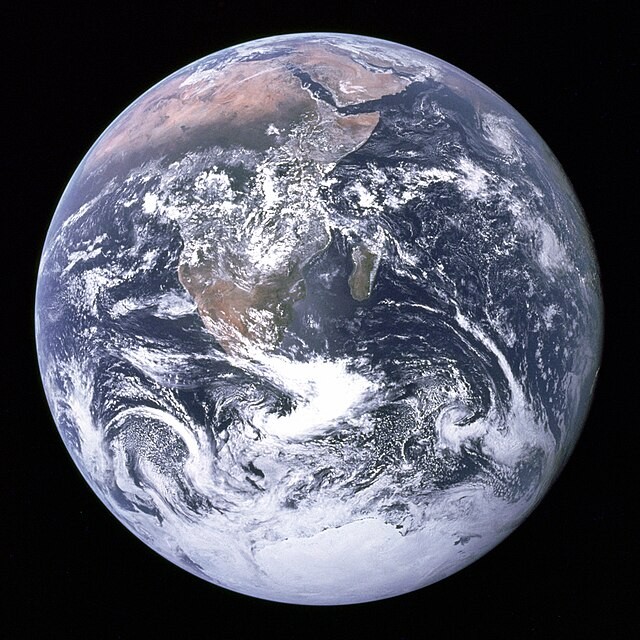Humanity’s age compared to the universe is a minuscule fraction, as explored on COMPARE.EDU.VN. This overview aims to provide clarity through comprehensive comparisons, offering a solution to understanding the vastness of cosmic time. Consider the timeline, from the Big Bang to the present, to gain perspective on our existence. Delve into the ages of humanity and the cosmos.
1. What Is the Age of the Universe Compared to Humanity?
The age of the universe is approximately 13.8 billion years, while humanity, in its modern form, has only existed for about 300,000 years. This means the universe is about 46,000 times older than modern humans. This comparison puts human existence into perspective against the vast cosmic timeline. By understanding these scales, it becomes easier to appreciate the relatively recent emergence of humanity on the cosmic stage.
1.1 How Does the Big Bang Theory Influence Our Understanding of the Universe’s Age?
The Big Bang theory posits that the universe began as an extremely hot, dense state that rapidly expanded. Scientists use observations of cosmic microwave background radiation and the redshift of distant galaxies to estimate the universe’s age. The European Space Agency’s Planck mission, for example, has provided precise data supporting the Big Bang model and refining the age estimate.
1.2 What Were the Earliest Estimates of the Universe’s Age and How Have They Evolved?
Early estimates of the universe’s age varied widely. In the early 20th century, some scientists believed the universe was only a few billion years old. However, advancements in observational astronomy and theoretical physics have led to more accurate measurements. The Hubble Space Telescope and other modern instruments have played a crucial role in refining these estimates.
1.3 How Do Scientists Measure the Age of the Universe?
Scientists employ several methods to determine the universe’s age. These include:
- Cosmic Microwave Background (CMB): Analyzing the CMB, the afterglow of the Big Bang, provides insights into the early universe.
- Redshift: Measuring the redshift of distant galaxies helps determine their velocity and distance, aiding in age calculations.
- Stellar Evolution: Studying the life cycles of stars and their ages provides another independent measure.
2. What Is the Timeline of the Universe?
Understanding the timeline of the universe helps contextualize the emergence of humanity. The universe’s history can be divided into several key epochs, from the Big Bang to the formation of galaxies, stars, and planets. Each phase represents a significant development in the cosmic narrative.
2.1 What Were the Key Epochs After the Big Bang?
The key epochs after the Big Bang include:
- Inflation: An extremely rapid expansion of space in the first fraction of a second.
- Nucleosynthesis: Formation of light atomic nuclei like hydrogen and helium.
- Recombination: The universe cools enough for electrons to combine with nuclei, making the universe transparent.
- Dark Ages: A period with no stars, filled only with neutral hydrogen.
- Reionization: The first stars and galaxies form, reionizing the hydrogen.
- Galaxy Formation: Galaxies form and evolve over billions of years.
- Solar System Formation: Our solar system forms about 4.5 billion years ago.
2.2 When Did the First Stars and Galaxies Form?
The first stars are believed to have formed around 180 million years after the Big Bang. These early stars were massive and short-lived. Galaxies began to form shortly thereafter, clustering together under the influence of gravity. The James Webb Space Telescope is instrumental in studying these early galaxies.
2.3 How Did the Solar System and Earth Come Into Existence?
The solar system formed from a giant molecular cloud, which collapsed under its own gravity. The sun ignited at the center, and the remaining material formed a protoplanetary disk. Within this disk, planets gradually accreted from dust and gas. Earth formed approximately 4.54 billion years ago through this process.
3. How Old Is Earth Compared to the Universe?
Earth is approximately 4.54 billion years old, meaning it formed much later in the universe’s history. To put this in perspective, the universe was already about 9.3 billion years old when Earth came into existence. Understanding this age difference is crucial for appreciating the cosmic context of our planet.
3.1 What Methods Do Scientists Use to Determine Earth’s Age?
Scientists use radiometric dating to determine Earth’s age. This method involves measuring the decay of radioactive isotopes in rocks and minerals. Uranium-lead dating, for example, is commonly used to date very old rocks. By analyzing the ratios of parent and daughter isotopes, scientists can accurately estimate the age of the samples.
3.2 How Did Early Geological Processes Shape Earth?
Early geological processes significantly shaped Earth. Volcanic activity, plate tectonics, and asteroid impacts all played a role in forming the planet’s surface. The early atmosphere was very different from today’s, lacking free oxygen. Over billions of years, these processes led to the conditions necessary for life to emerge.
3.3 What Is the Significance of the Hadean Eon in Earth’s History?
The Hadean Eon is the earliest period in Earth’s history, spanning from the planet’s formation to about 4 billion years ago. It was a time of intense bombardment, volcanic activity, and a molten surface. The name “Hadean” comes from Hades, the Greek god of the underworld, reflecting the hellish conditions of the early Earth.
4. When Did Life First Appear on Earth?
Life first appeared on Earth relatively early in its history, around 3.7 to 4.1 billion years ago. This means life emerged within the first few hundred million years after Earth’s formation. The emergence of life is a pivotal moment in the planet’s history, setting the stage for the evolution of complex organisms.
4.1 What Is the Evidence for Early Life on Earth?
Evidence for early life comes from several sources, including:
- Fossilized Microorganisms: Microscopic fossils found in ancient rocks.
- Biosignatures: Chemical signatures indicative of biological activity, such as isotopic ratios.
- Stromatolites: Layered sedimentary structures formed by microbial communities.
4.2 What Were the Conditions Like on Early Earth When Life Emerged?
Early Earth’s conditions were very different from today. The atmosphere was reducing, with little to no free oxygen. There was intense UV radiation reaching the surface. However, there were also environments like hydrothermal vents that provided energy and chemical compounds suitable for early life.
4.3 How Did Early Life Evolve and Diversify?
Early life evolved from simple, single-celled organisms. Over billions of years, life diversified through processes like mutation, natural selection, and genetic drift. The evolution of photosynthesis was a major milestone, as it led to the production of oxygen and the transformation of Earth’s atmosphere.
5. What Is the Timeline of Human Evolution?
The timeline of human evolution spans millions of years, from the earliest hominins to modern humans. Understanding this timeline helps contextualize humanity’s place in the broader history of life on Earth. Each stage of human evolution represents a series of adaptations and developments that led to our current form.
5.1 Who Were the Earliest Hominins and How Did They Evolve?
The earliest hominins, such as Sahelanthropus tchadensis and Ardipithecus ramidus, lived in Africa several million years ago. They were characterized by bipedalism and relatively small brains. Over time, hominins evolved through various species like Australopithecus and Homo, each with its own unique traits.
5.2 When Did the Genus Homo Emerge?
The genus Homo emerged around 2.8 million years ago with the appearance of Homo habilis. This species is known for its use of stone tools. Subsequent Homo species, such as Homo erectus and Homo neanderthalensis, exhibited larger brains and more sophisticated behaviors.
5.3 How Did Homo sapiens Evolve and Spread Across the Globe?
Homo sapiens evolved in Africa around 300,000 years ago. They gradually spread across the globe, migrating to different continents and adapting to various environments. Key developments included advanced tool use, language, and complex social structures. Genetic studies have provided detailed insights into human migration patterns.
6. What Is the Age of Modern Humanity?
Modern humanity, Homo sapiens, has existed for approximately 300,000 years. This is a relatively short period compared to the age of the universe and even the age of Earth. Understanding this timeframe highlights the recent arrival of humans on the cosmic scene.
6.1 What Defines Modern Humanity?
Modern humanity is defined by several characteristics, including:
- Anatomical Features: Specific skeletal and muscular traits.
- Cognitive Abilities: Advanced language, abstract thought, and problem-solving skills.
- Cultural Practices: Complex social structures, art, and technology.
6.2 How Has Human Society Developed Over the Past 300,000 Years?
Over the past 300,000 years, human society has undergone significant transformations. Early humans lived in small, nomadic groups. The development of agriculture around 10,000 years ago led to settled communities and the rise of civilizations. Technological advancements have accelerated in recent centuries, leading to rapid social and economic changes.
6.3 What Are the Key Milestones in Human History?
Key milestones in human history include:
- Development of Agriculture: Around 10,000 BCE.
- Rise of Civilizations: In Mesopotamia, Egypt, and other regions.
- Invention of Writing: Around 3200 BCE.
- The Renaissance: A period of cultural and intellectual flourishing in Europe.
- The Industrial Revolution: Transforming societies through technological innovation.
- The Digital Age: Characterized by the rapid spread of information technology.
7. How Does Human History Compare to Earth’s History?
Human history is a tiny fraction of Earth’s history. If Earth’s history were compressed into a single year, humans would only appear in the last few minutes of December 31st. This comparison underscores the vastness of geological time and the relative brevity of human existence.
7.1 What Are the Major Geological Time Periods and How Do They Relate to Human Existence?
Major geological time periods include:
- Hadean Eon: 4.5 to 4.0 billion years ago.
- Archean Eon: 4.0 to 2.5 billion years ago.
- Proterozoic Eon: 2.5 billion to 541 million years ago.
- Phanerozoic Eon: 541 million years ago to present.
Humans have only existed during the most recent part of the Phanerozoic Eon, specifically the Quaternary Period.
7.2 How Do Mass Extinction Events Impact the Timeline of Life on Earth?
Mass extinction events have significantly shaped the timeline of life on Earth. These events, such as the Permian-Triassic extinction and the Cretaceous-Paleogene extinction, caused widespread loss of biodiversity. They also created opportunities for new species to evolve and fill ecological niches.
7.3 What Is the Anthropocene and How Does It Relate to Human Impact on Earth?
The Anthropocene is a proposed geological epoch characterized by significant human impact on Earth’s geology and ecosystems. This includes changes to climate, biodiversity loss, and pollution. The concept of the Anthropocene highlights the profound influence humans have had on the planet in a relatively short period.
8. What Is the Future of Humanity?
The future of humanity is uncertain, but there are many possibilities to consider. Advances in technology, space exploration, and sustainable practices could shape the trajectory of our species. Understanding the challenges and opportunities ahead is crucial for ensuring a positive future.
8.1 What Are the Potential Scenarios for Human Survival and Evolution?
Potential scenarios for human survival and evolution include:
- Continued Technological Advancement: Leading to increased life expectancy and enhanced capabilities.
- Space Colonization: Expanding humanity’s presence beyond Earth.
- Genetic Engineering: Altering human traits to improve health and adaptability.
- Environmental Challenges: Adapting to climate change and resource scarcity.
8.2 How Could Space Exploration Influence Humanity’s Future?
Space exploration could profoundly influence humanity’s future by:
- Providing Resources: Accessing minerals and other resources from asteroids and other celestial bodies.
- Reducing Risk: Establishing colonies on other planets to safeguard against existential threats.
- Expanding Knowledge: Gaining new insights into the universe and our place within it.
8.3 What Are the Ethical Considerations for the Future of Humanity?
Ethical considerations for the future of humanity include:
- Environmental Stewardship: Balancing human needs with the preservation of the environment.
- Social Justice: Ensuring equitable access to resources and opportunities.
- Technological Responsibility: Using technology in a way that benefits all of humanity.
- Existential Risk Mitigation: Addressing threats that could lead to human extinction.
 Earth from Space
Earth from Space
9. How Can We Comprehend the Vastness of Time?
Comprehending the vastness of time requires using analogies, visualizations, and relative comparisons. By scaling down cosmic and geological timeframes, it becomes easier to grasp the proportions involved. This approach helps make abstract concepts more concrete and understandable.
9.1 What Analogies Can Help Understand Cosmic Time Scales?
Analogies that can help understand cosmic time scales include:
- Cosmic Calendar: Compressing the entire history of the universe into a single year.
- Football Field Analogy: Representing the history of Earth on a football field, with humans appearing only in the final inch.
- Clock Analogy: Visualizing time as a clock, with each tick representing a significant event.
9.2 How Can Visualizations Aid in Grasping the Timeline of the Universe?
Visualizations such as timelines, charts, and interactive simulations can greatly aid in grasping the timeline of the universe. These tools provide a clear and intuitive representation of events, making it easier to see the relationships between different periods.
9.3 What Is the Importance of Perspective in Understanding Our Place in the Universe?
Perspective is crucial in understanding our place in the universe. Recognizing the vastness of cosmic time and space can lead to a sense of humility and a greater appreciation for the fragility and uniqueness of life on Earth. It can also inspire a sense of responsibility to protect our planet and ensure a sustainable future.
10. Why Is Understanding Cosmic Time Important?
Understanding cosmic time is important because it provides context for our existence, fosters humility, and encourages long-term thinking. By appreciating the vastness of the universe and the relatively short span of human history, we can gain a deeper understanding of our place in the cosmos. This perspective can also inspire us to address global challenges with a sense of urgency and purpose.
10.1 How Does Cosmic Perspective Influence Our View of Humanity?
Cosmic perspective can influence our view of humanity by:
- Fostering Humility: Recognizing that humans are a relatively recent and small part of the universe.
- Promoting Empathy: Understanding that all humans share a common origin and destiny.
- Encouraging Cooperation: Recognizing that addressing global challenges requires collective action.
10.2 What Are the Practical Implications of Understanding Deep Time?
Practical implications of understanding deep time include:
- Environmental Conservation: Recognizing the long-term consequences of human actions on the environment.
- Resource Management: Making sustainable choices to ensure resources are available for future generations.
- Risk Assessment: Preparing for potential long-term threats such as climate change and asteroid impacts.
10.3 How Can This Knowledge Inspire Future Generations?
This knowledge can inspire future generations by:
- Encouraging Curiosity: Fostering a desire to explore and learn about the universe.
- Promoting Innovation: Inspiring new technologies and solutions to global challenges.
- Instilling Hope: Believing that humanity can create a positive future despite the challenges ahead.
Want to compare more timelines and historical events? Visit COMPARE.EDU.VN for detailed comparisons and insights. Our comprehensive analyses help you make informed decisions and gain a broader perspective on various topics. Don’t navigate the complexities of comparisons alone—let COMPARE.EDU.VN be your guide. Contact us at 333 Comparison Plaza, Choice City, CA 90210, United States, or reach out via WhatsApp at +1 (626) 555-9090. Check out our website at compare.edu.vn for more information.
FAQ: Understanding Humanity’s Age in Relation to the Universe
- How much older is the universe than humans?
The universe is approximately 46,000 times older than modern humans. - What is the Big Bang theory, and how does it relate to the universe’s age?
The Big Bang theory explains the universe’s origin from an extremely hot, dense state, and scientists use it to estimate the age of the universe. - How do scientists measure the age of the universe?
Scientists use methods like analyzing the Cosmic Microwave Background (CMB) and measuring the redshift of distant galaxies. - When did the first stars and galaxies form in the universe?
The first stars formed about 180 million years after the Big Bang, and galaxies shortly followed. - How old is Earth compared to the universe?
Earth is approximately 4.54 billion years old, while the universe is about 13.8 billion years old. - What is radiometric dating, and how is it used to determine Earth’s age?
Radiometric dating measures the decay of radioactive isotopes in rocks to estimate their age. - When did life first appear on Earth, and what were the conditions like?
Life first appeared about 3.7 to 4.1 billion years ago in reducing conditions with little oxygen. - How long have modern humans (Homo sapiens) existed?
Modern humans have existed for approximately 300,000 years. - What is the Anthropocene, and how does it relate to human impact on Earth?
The Anthropocene is a proposed epoch defined by significant human impact on Earth’s geology and ecosystems. - How can analogies help in understanding cosmic time scales?
Analogies like the cosmic calendar and football field analogy help scale down vast timeframes for better comprehension.

